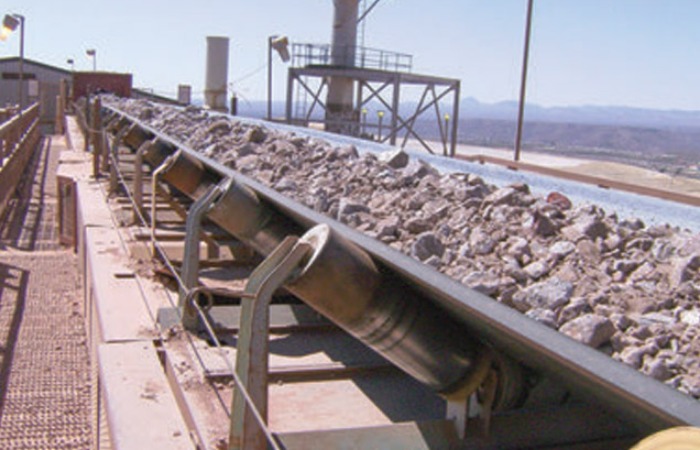
Belt Conveyor Danger Zones
Recognising the hazards is a key step toward preventing conveyor-related injuries.
In bulk material handling applications, a conveyor is typically a massive, complex and extremely powerful system. It is usually constructed of rubber belting, set on rolling idlers, wrapped around large steel drums at each end and driven by a high-torque motor. As such, a conveyor presents enough danger zones that the entire system should be considered a hazard.
The belt
In most applications, a conveyor belt moves at a relatively constant speed, commonly running somewhere between 0.5 and 10 m/s [100-2,000 fpm]. An Olympic sprinter has a reaction time of about 0.18 second (roughly one-fifth of a second) when poised at the starting line and totally focused on the race. If this athlete becomes tangled in a conveyor belt travelling 1.5 m/s [300 fpm], the person would be carried 0.27 m [10.6 inches] before even realising what has happened.
A ‘regular’ worker would likely require a longer time to react. For simplicity’s sake, we can assume it would be twice the athlete’s reaction time, so the worker would be pulled twice as far, introducing the potential to strike many more components or to be pulled farther and harder into the first one. In addition, most conveyors are engineered with the ability to start remotely. The system may go from dormant to active at any time at the push of a button, and that ability can suddenly catch a worker unaware, leading to serious injury or death.
“When a conveyor belt is moving, there will usually be more tension on the carrying side,” observed Dan Marshall, Martin Engineering Process Engineer. “If the conveyor is merely stopped and de-energised, that tension may remain in the belt in the form of stored energy.”
Marshall reminded that a system under tension will always try to approach equilibrium; that is, it will try to release the energy. This release will likely come in the form of a pulley slip, which occurs when the belt slides around the head pulley to equalise the tension. The distance the belt will move is proportional to the amount of tension stored and the belt’s modulus (elasticity), possibly several feet. If a worker is on the belt or close enough to be pulled in during this sudden release of energy, injuries or death can occur.
The system
“There is a simple rule of thumb regarding conveyors: If it is moving, don’t touch it,” Marshall continued. “The most common way to prevent inadvertent contact is with suitable guarding that renders the moving components inaccessible.” For maintenance or repairs, procedures for lockout, tag-out, block-out, or test-out should always be followed when working on a stationary conveyor, and systems should be equipped with anti-rollback devices (also known as backstops) on the head pulley.
Many of the moving parts on a conveyor belt system are rotating components. These parts include idlers, drive shafts, couplings, pulleys and speed sensors. Items rotating at a high speed pose the risk of entanglement or entrapment. “All moving machine parts should be guarded with adequately constructed, properly installed, functioning and well-maintained guards,” said Marshall.
There are many pinch points on a conveyor, components that the belt actually touches or comes near, including the drive pulleys, snub pulleys, idlers, stringer, chute walls and deflectors. If a worker’s limb travels with a conveyor belt, it will meet one of these components. The limb, as well as its attached worker, will become trapped between the belt and the obstruction.
The same thing can happen with a tool, which can pull a worker into the entrapment faster than the person can let go. “Effective fixed guards should be absolute in their protection; workers should not be able to reach around, under, through or over the barrier separating them from moving components,” Marshall added.
Many of the fatalities around conveyors have happened when a worker was cleaning fugitive material from the structure or components of a conveyor system. The process of cleaning may put a worker in proximity to a very dangerous machine. The need to shovel, sweep or hose off accumulations, puts the worker within arm’s length of the conveyor, and often closer.
Airborne dust can cause numerous health risks, ranging from material buildup in the lungs to explosions. Categorised as either respirable or inhalable according to particle size, dry, solid dust particles generally range from about one to 100 microns (µm) in diameter. According to the EPA, inhalable coarse particles are 2.5-10 µm in size. They are typically caught by the human nose, throat or upper respiratory tract. In contrast, fine respirable particles (under 2.5 µm) can penetrate beyond the body’s natural cleaning mechanisms (cilia and mucous membranes), travelling deep into the lungs and causing long-term or chronic breathing issues.
While it is virtually impossible to prevent ALL fugitive material from escaping a conveyor structure, taking practical steps to minimise it as much as possible helps reduce the dangers it can introduce. When cleanup is necessary, performing the job while the conveyor is running should not be an option. Operators concerned with the cost of lost production from stopping a conveyor to clean need only consider the consequences of an accident to confirm the wisdom of this rule.
Knowing the hazards
Until recently, the engineering of belt conveyors to carry bulk materials hadn’t changed much in the last half-century, despite the fact that virtually every requirement for safety, regulatory compliance and production performance has been raised during that time. Standards continue to tighten and industry best practices now often exceed government requirements.
“Using these new and emerging technologies, even poorly performing conveyors often don’t need to be replaced or rebuilt, but merely modified and reconfigured by knowledgeable and experienced technicians installing the right modern equipment,” Marshall concluded. “Specialised conveyor training and trusted resources from global suppliers are helping to raise operator awareness to make conveyor systems cleaner, safer and more productive.”
Article courtesy: Martin Engineering


 +91-22-24193000
+91-22-24193000 Subscriber@ASAPPinfoGlobal.com
Subscriber@ASAPPinfoGlobal.com